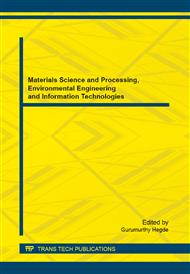[1]
W. Zhang, X. C Lu, Y.H. Liu, G.S. Pan, J.B. Luo, Inhibitors for organic phosphonic acid system abrasive free polishing of Cu, Appl. Surf. Sci. 255 (2009) 4114-4118.
DOI: 10.1016/j.apsusc.2008.10.096
Google Scholar
[2]
F. Liu, M.P.F. Sutcliffe, Modeling of delamination of ultra low-k material during chemical mechanical polishing, Tribol. Lett. 25 (2007) 225-236.
DOI: 10.1007/s11249-006-9171-z
Google Scholar
[3]
R.L. Chen, The collision mechanism between the silica clusterand the silicon surface studied by molecular dynamics simulation, PhD thesis, Beijing, Tsinghua University, (2008).
Google Scholar
[4]
B.J. Alder, T.E. Wainwright, Studies in molecular dynamics I. general method, J. Chem. Phys. 31 (1959) 459-466.
Google Scholar
[5]
L.M. Cook, Chemical process in glass polishing, J. Non-Cryst. Solids. 120 (1990) 152-171.
Google Scholar
[6]
Y.Y. Ye, R. Biswas, J. R. Morris, A. Bastawros, A. Chandra, Molecular dynamics simulation of nanoscale machining of copper, Nanotechnology. 14 (2003) 390-396.
DOI: 10.1088/0957-4484/14/3/307
Google Scholar
[7]
E. Chagarov, J.B. Adams, Molecular dynamics simulations of mechanical deformation of amorphous silicon dioxide during chemical mechanical polishing, J. Appl. Phys. 94 (2003) 3853-3861.
DOI: 10.1063/1.1602551
Google Scholar
[8]
X.S. Han, Study micromechanism of surface planarization in the polishing technology using numerical simulation method, Appl. Surf. Sci. 253 (2007) 6211-6216.
DOI: 10.1016/j.apsusc.2007.01.115
Google Scholar
[9]
L.C. Zhang, H. Tanaka, Atomic scale deformation in silicon monocrystals induced by two-body and three-body contact sliding, Tribol. Int. 31 (1998) 425-433.
DOI: 10.1016/s0301-679x(98)00064-4
Google Scholar
[10]
J.F. Luo, D.A. Dornfeld, Material removal mechanism in chemical mechanical polishing: theory and modeling, IEEE Trans. Semicond. Manuf. 14 (2001) 112-133.
DOI: 10.1109/66.920723
Google Scholar
[11]
Y.G. Wang, Y.W. Zhao, W. An, Z.F. Ni, J. Wang, Modeling effects of abrasive particle size and concentration on material removal at molecular scale in chemical mechanical polishing, Appl. Surf. Sci. 257 (2010) 249-253.
DOI: 10.1016/j.apsusc.2010.06.077
Google Scholar
[12]
L.N. Si, D. Guo, J. B Luo, X.C. Lu, Monoatomic layer removal mechanism in chemical mechanical polishing process: A molecular dynamics study, J. Appl. Phys. 107 (2010) 064310.
DOI: 10.1063/1.3327448
Google Scholar
[13]
Y. Moon, Mechanical aspect of the material removal mechanism in chemical mechanical polishing, PhD thesis, Berkeley: University of California, (2002).
Google Scholar
[14]
G. Ahmadi, X. Xia, A model for mechanical wear and abrasive particle adhesion during the chemical mechanical polishing process, J. Eelectrochem. Soc. 148 (2001) G99-G109.
DOI: 10.1149/1.1346614
Google Scholar
[15]
F.L. Duan, J.B. Luo, S.Z. Wen, Atomic structural of silicon surface under collision of nanoparticle, Chin. Sci. Bull. 50 (2005) 1661-1665.
Google Scholar
[16]
Z.G. Huang, Z.N. Guo, X. Chen, Z.Q. Yu, T.M. Yu, W.B. Lee, Microscopic machining mechanism of polishing based on vibrations of liquid, Nanotechnology. 18 (2007) 105703.
DOI: 10.1088/0957-4484/18/10/105703
Google Scholar
[17]
R.L. Chen, J.B. Luo, D. Guo, X.C. Lu, Energy transfer under impact load studied by molecular dynamics simulation, J. Nanoparticle Res. 11 (2009) 589-600.
DOI: 10.1007/s11051-008-9398-8
Google Scholar
[18]
X.S. Han, Analysis the physical essence of microscopic fluid-based wear process in the chemical mechanical planarization process, J. Appl. Phys. 110 (2011) 063525.
DOI: 10.1063/1.3626798
Google Scholar
[19]
G.R. Abrahamson, E.J. Duwell, W.J. McDonald, Wear and lubrication as observed on a lap table with loose and bonded abrasive Grit, Trans. ASME J. Tribol. 113 (1991) 249-254.
DOI: 10.1115/1.2920613
Google Scholar
[20]
C.H. Zhou, L. Shan, J.R. Hight, S. Danyluk, S.H. Ng, A.J. Paszkowski, Influence of colloidal abrasive size on material removal rate and surface finish in SiO2 chemical mechanical polishing, Tribol. Trans. 45 (2002), 232-238.
DOI: 10.1080/10402000208982545
Google Scholar
[21]
L.N. Si, D. Guo, J.B. Luo, X.C. Lu, G.X. Xie, Abrasive rolling effects on material removal and surface finish in chemical mechanical polishing analyzed by molecular dynamics simulation, J. Appl. Phys. 109 (2011) 084335.
DOI: 10.1063/1.3575177
Google Scholar


